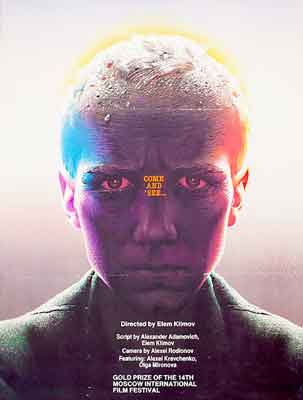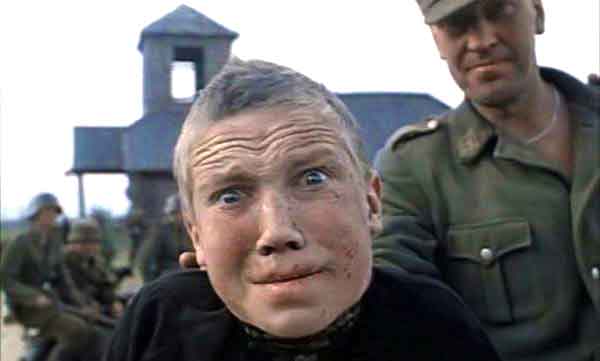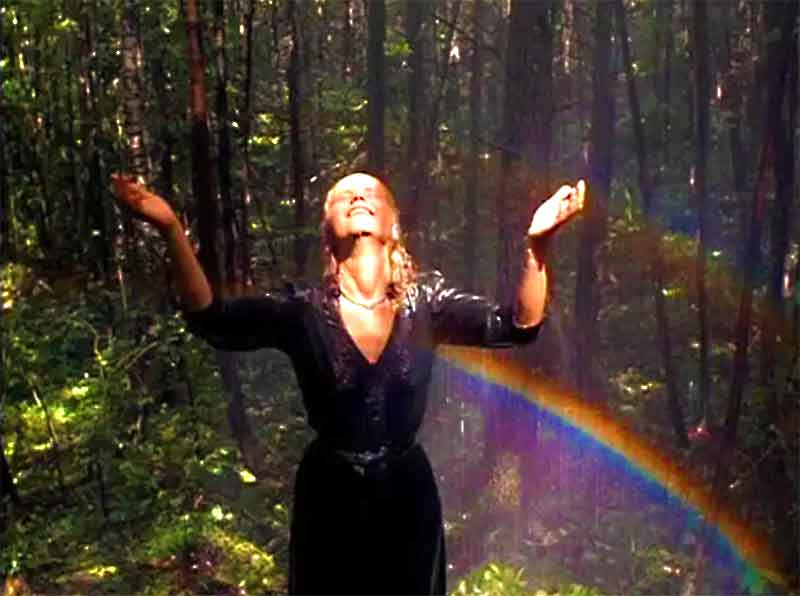 This shattering, impressionistic Russian epic can be viewed as a hallucinatory depiction of the horrors of war, an unforgiving expose of Nazi atrocities that makes SCHINDLER’S LIST look like LASSIE COME HOME, or as a straightforward descent into madness. COME AND SEE is a visionary masterpiece in any interpretation, a film from which no viewer will emerge unchanged.
This shattering, impressionistic Russian epic can be viewed as a hallucinatory depiction of the horrors of war, an unforgiving expose of Nazi atrocities that makes SCHINDLER’S LIST look like LASSIE COME HOME, or as a straightforward descent into madness. COME AND SEE is a visionary masterpiece in any interpretation, a film from which no viewer will emerge unchanged.
COME AND SEE (IDI I SMOTRI; 1985), the undoubted masterwork of filmmaker Elem Klimov, was initially conceived and scripted in the mid-seventies, following the completion of Klimov’s Rasputin biopic AGONY. COME AND SEE, originally titled KILL HITLER!, was based on a novella, THE KHATYN STORY by Ales Adamovich, which was inspired by its author’s own WWII experiences. Klimov further drew upon his own childhood memories of the war in crafting the script.
The Russian film industry being the lumbering, inefficient machine it was in those pre-Glasnost days, it took seven years for COME AND SEE to begin production (while AGONY remained shelved until the mid-eighties). In the interim Klimov’s wife, filmmaker Larissa Shepitko, whose masterful WWII drama ASCENT (1976) can be seen as a sort of dry run for COME AND SEE, was killed in a car accident. Her widow’s grief haunts the latter film, which was to be Klimov’s last. He was set to direct an adaptation of Mikhail Bulgakov’s satiric classic THE MASTER AND MARGARITA, which never came to pass. Reportedly, in the wake of COME AND SEE, Klimov “lost interest” in making films. He died in 2003, shortly after COME AND SEE’S long-awaited debut on DVD in the US.
Florya is a naïve young boy living with his mother and two younger sisters in the Soviet region of Byelorussia sometime in the late thirties. Digging in a cemetery one day with a friend, Florya unearths an antique rifle from a dead man’s grave, and in the process alerts a Nazi pilot to his presence—and that of the village in which he lives.
Later that day some soldiers show up at Florya’s house, recruiting able-bodied young men to fight the invading Nazis; Florya eagerly joins the cause, presenting the newfound antique rifle as proof of his readiness. Upon arriving at the Partisan base camp, alas, Florya finds his heroic dreams shattered as he’s branded “the new kid” and forced to do odd jobs. Worst of all, he’s left behind to look after things when it comes time for the company to march off to battle. There is compensation, however, in the form of Glascha, an alluring peasant girl who’s been sleeping with the company’s leader. She turns her attentions to Florya, but their relationship is interrupted by Nazi bombings, during which Florya is briefly struck deaf.
Florya decides to take Glascha back to his mother’s home, but finds it and the surrounding town strangely deserted. He figures the townspeople must have decamped to a nearby island, but Glascha spots a mass of dead bodies stacked against the side of a house and realizes the truth: that the invading Nazis have massacred everybody in the village. After a nightmarish slog through a muddy swamp, Florya is forced to face the painful truth of the killings of all his friends and family, and adjust to a new reality of horror and sudden death.
From there Florya is plunged deeper into wartime mayhem, taking off on a desperate trek with three surviving townspeople, all of whom are killed by enemy fire. Eventually Florya finds himself trapped in a Nazi-occupied Bylorussian town (patterned after Khatyn, the site of a 1943 massacre) as its citizens are forced into a church, which the Nazis then burn to the ground. In the conflagration Florya’s hair turns grey and his face becomes wrinkled. A young woman who closely resembles Glascha (and no wonder, as both characters were played by the same actress) is also drawn into the mayhem, and ends up a catatonic vegetable after being gang raped. The partisan forces ultimately manage to ambush the Nazi invaders and kill them all, but the horror of all he’s experienced will scar Florya forever.
As he proved in his brilliant films FAREWELL and AGONY, Elem Klimov was unsurpassed in his ability to create nightmarish imagery. He demonstrates that talent again and again in COME AND SEE, which contains a wealth of profoundly unsettling, impossible to forget scenes, from a close-up a dying cow’s eye moving back and forth in its socket to the panoramic climax, with hundreds of extras forcibly marched to their death, certainly one of the most traumatizing sequences in cinema history. However, Klimov also manages to conjure moments of poetic beauty, such as the strangely elegiac sight of young Glascha dancing in the rain or the protagonist’s final majestic march through a vast forest. Equally impressive is Klimov’s use of sound, particularly in the bit where the protagonist is deafened by artillery fire, conveyed via a haunting electronic buzz. Also, after experiencing this film I guarantee you’ll never be able to listen to the drone of a biplane in quite the same way.
The lead performance of 13-year-old Alexei Kravchenko is a large part of what makes the film so effective. His work here is among the most powerful pre-pubescent emoting I’ve witnessed, managing to convey a profound and decidedly unchildlike sense of a person at the end of his emotional rope, presented with such intensity that the filmmakers were worried the young Kravchenko might literally go mad; for this reason, much of his performance was apparently achieved under hypnosis. The climactic close-ups of the actor’s prematurely wrinkled, grief-stricken face are among the film’s most powerful images.
One thing that puzzles me are the statements of Klimov and others who worked on the film, all of whom constantly reiterate the director’s apparent dictum that everything in the film be as naturalistic as possible. Certainly that tendency seems to have been rigorously followed in the production design, but otherwise this one of the most heavily stylized movies I’ve seen. Indeed, I’d venture to call COME AND SEE one of the great impressionistic films ever, as mind bending as anything by Jodorowski and Arrabal. The film is chock full of bizarre scenes, such as the construction of a Hitler scarecrow by a soldier affixing mud to a skull, or the protagonist digging a gun out of the ground in blatantly sexual fashion. There are even moments of outright surrealism, such as a crawl through a muddy bog that in the next scene becomes a lake. And let’s not forget Klimov’s most audacious sequence, a newsreel montage depicting the rise of the Third Reich in reverse chronology. The cumulative effect is one of profound horror of a depth few other films have been able to approach, much less match.
Vital Statistics
COME AND SEE (IDI I SMOTRI)
Byelorusfilm/Mosfilm Studios
Director: Elem Klimov
Screenplay: Elem Klimov, Ales Adamovich
(Based on a novel by Ales Adamovich)
Cinematography: Alexei Rodionov
Editing: V. Velova
Cast: Alexei Kravchenko, Olga Mironova, Lubomiras Lauciavicius, Vladas Bagdonas, Juris Lumiste, Víktor Lorents, Kazizmir Rabetsky, Yevgeni Tilicheyev, Akeksandr Berda, Igor Gnevashev, Vasili Domrachyov


